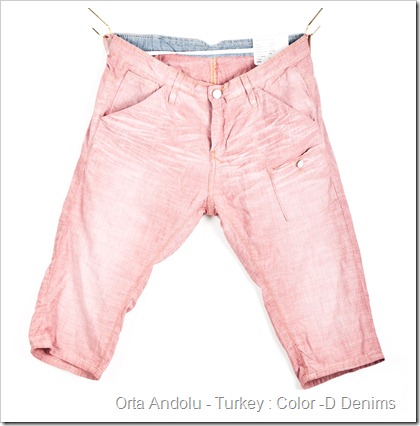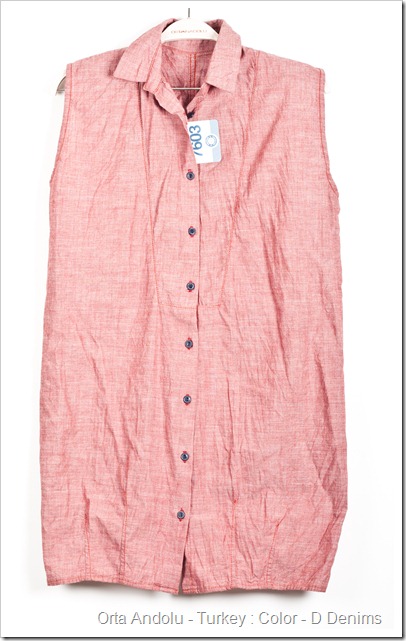This is a guest post by Harry Mercer.
For denim executives that are trying to anticipate the next big fashion trend, there are clear indications of what that trend will be. The indications are that denim in a wide range of colors is emerging as the most promising path to significantly improved denim business by 2013. These are other than the pure Indigo blue, sulfur bottoms, sulfur tops and black shades that dominate the denim market. The availability of denim colors in the world market is presently very small because only a very few denim companies have overcome the technical challenges of dyeing colors on standard denim equipment. These problems along with the route to success in producing colors will be explained in following article.
The technical aspects of controlling colors on Indigo machinery consist of:
1) Understanding affinity factors( the velocity of dye particles) of indigo and sulfur dyeing
2) Control of reduction potential(millivolts) and alkalinity(pH) of indigo and sulfur dye
3)Dye box volumes( larger boxes are better for Indigo, smaller are better for sulfurs)
4) Control of wet pick-up where dyes are applied to dry cotton and the concept of “liquor exchange” where dye is applied to wet cotton
5) Effective washing for maintaining color consistency
6) Control of oxidation, especially with sulfur dyes to avoid strength loss with blacks and the extreme color variation with colors other than black. These will be addressed in detail in the following article.
These color denims are appearing in increasing volumes in higher-fashion retail stores such as Dillards in the U.S. as well as in Europe and Japan. These include yarn-dyed denims with the white weft preserved and garment dyes which can be produced with sulfur dyes, reactives, directs or pigments. One constant in yarns dyed by Indigo machinery is that there will be an undyed, white center in the yarns regardless of which class of dye or dyeing method is used. The reserved, undyed cotton in the center of the yarns is responsible for the unique brightness of denim garments. Light is reflected from the dyed fibers on the outside of the yarns, but also from the white fibers in the center which results in a special brightness that has been described as “blooming”.
Sulfur dyed garments seem to have greater appeal because of the more natural looking “earth tones” that are generated. Reactives have a more intense appearance because of the higher chroma, but are more expensive and are perceived as being artificial. Direct dyes are the lowest cost to use and there are pink and light greens that have penetrated the market, but present colorfastness problems in dark shades. Pigments are relatively easy to apply and since they are a surface coloration, can produce a distressed look, but also present colorfastness problems in darker shades and have a harsher feel than dyed garments. Sulfur colors offer easy application, are very low cost and can produce a wide range of colors that imitate colors in nature which have a more durable appeal in the higher-fashion markets. The basic procedure for producing sulfur dyes is to take “any organic compound with color and react it with sulfur”, so any naturally occurring material can be used to produce sulfur dyes. When sulfur dyes were introduced in the 1870’s, the first colors were brown dyes produced from sawdust, animal blood and horse manure reacted with sulfurs. More sophisticated methods since then have resulted in a full palette of colors with sulfur dyes.
The expression “sulfur colors” refers to colors like browns, greens, yellow, violets, greys, pinks and oranges, colors that will stand out in stores and catch the attention of retail consumers that are ready for something fresh to wear, but are in the unique denim fabric constructions.
The presence of white weft-yarns behind the colored weft yarns makes for a brighter, cleaner appearance and because the weft yarns have not been affected by dyes or chemicals, the feel of natural cotton against the skin is one of the important reasons for the appeal of denim.
Denim colors first became a huge success in the fashion denim area about 20 years ago, when U.S. companies invested in research programs to solve the mysteries of the physical chemistry involved in continuous dyeing on Indigo machinery, which none of the dye suppliers was able to solve. A serious effort is required which involves a basic understanding of color science, the chemistry of dyeing, especially the selection of reducing agents and special buffers to maintain stability in the large dye boxes of Indigo machinery, but the profit margins to be realized will make the effort financially worthwhile, especially for smaller, more flexible and technically capable denim companies.
The business cycle in fashion has always demonstrated that the fabric supplier who enters the market first with an entirely new product gains the greatest share of the profits form product development. Those who try to catch up and wait to follow the leaders will continue to struggle.







